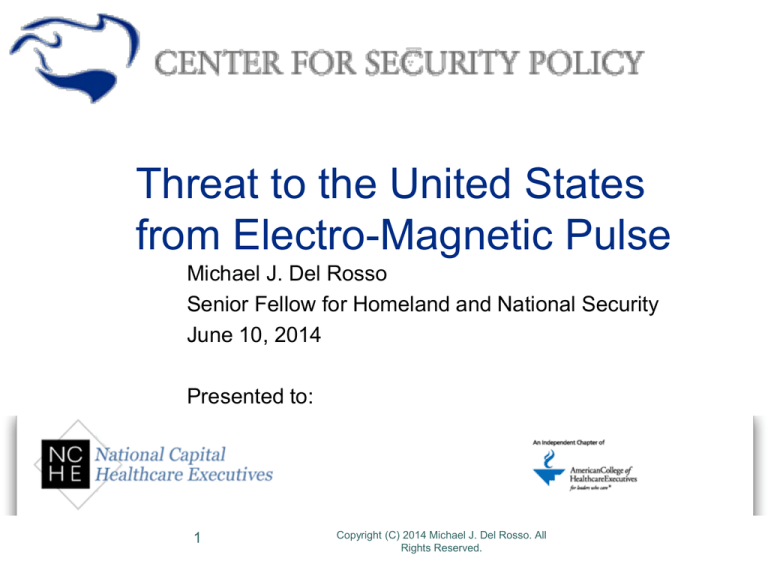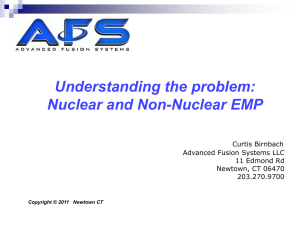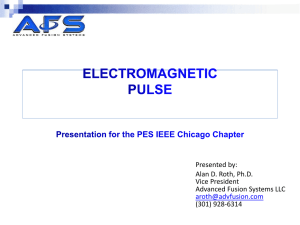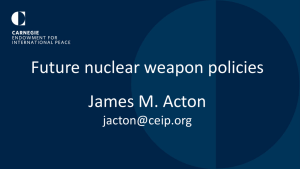
Threat to the United States
from Electro-Magnetic Pulse
Michael J. Del Rosso
Senior Fellow for Homeland and National Security
June 10, 2014
Presented to:
1
Copyright (C) 2014 Michael J. Del Rosso. All
Rights Reserved.
Electromagnetic Pulse (EMP) – an
Existential Threat to America’s
Critical Electric Infrastructures
High altitude nuclear EMP (HEMP)
Geomagnetic Storms / Carrington Super
Flare
Non-nuclear Radio Frequency Weapons
(RFW)
There is a real risk of loss of sovereignty
Copyright (C) 2014 Michael J. Del Rosso. All
Rights Reserved.
2
Multiple Concurring Studies, no
Government Studies to the
Contrary
U.S. Congressional Commission to Assess the Threat
to the United States from Electro-Magnetic Pulse
Attack
U.S. Congressional Commission on the Strategic
Posture of the United States
U.S. National Academy of Sciences National
Research Council Report: Severe Space Weather
Events
U.S. DOE NERC Report: High-Impact, LowFrequency Event Risk to the North American Bulk
Power System
U.S. Oak Ridge National Laboratory Report: Electromagnetic Pulse: Effects on the U.S. Power Grid
UK House of Commons Defence Committee:
Developing Threats: Electro-Magnetic Pulses
(EMP)
Copyright (C) 2014 Michael J. Del Rosso. All
Rights Reserved.
3
Commission to Assess the Threat to
the United States from
Electromagnetic Pulse (EMP) Attack
EMP Commission established by the US Congress in 2001
2004 Executive Report
2008 Critical National Infrastructures Report
“The electromagnetic fields produced by weapons designed and deployed
with the intent to produce EMP have a high likelihood of damaging
electrical power systems, electronics, and information systems upon which
American society depends. Their effects on dependent systems and
infrastructures could be sufficient to qualify as catastrophic to the Nation.”
DHS responsible for mitigating threat, but to date have ignored all EMP
Commission recommendations
Existential threat to nation; potentially 200+ million deaths
Biggest problem is articulating problem and persuading responsible
parties AND GOVERNMENT to take action
Copyright (C) 2014 Michael J. Del Rosso. All
Rights Reserved.
4
Nuclear HEMP Over
Cincinnati, OH
Copyright (C) 2014 Michael J. Del Rosso. All
Rights Reserved.
5
74.4% of US Generation
Capacity Exposed
Copyright (C) 2014 Michael J. Del Rosso. All
Rights Reserved.
6
83% of Major Substations
Exposed
Copyright (C) 2014 Michael J. Del Rosso. All
Rights Reserved.
7
Geomagnetic Storm
A NASA report described an historic solar storm like this: “The 1859 storm – known
as the "Carrington Event" after astronomer Richard Carrington who witnessed the
instigating solar flare – electrified transmission cables, set fires in telegraph offices
and produced Northern Lights so bright that people could read newspapers by their
red and green glow. “
According to the National Academy of Sciences, a similar space weather event
today would have a far more profound impact: “An estimate of $1 trillion to $2
trillion during the first year alone was given for the societal and economic costs of a
‘severe geomagnetic storm scenario’ with recovery times of 4 to 10 years.”
As the Washington Post recently reported:
The problem is far from theoretical. Last month, at a conference on space weather held by the
National Oceanic and Atmospheric Administration, Daniel N. Baker of the University of
Colorado told the audience that the sun had unleashed another large coronal mass ejection in
July 2012 that traveled at speeds comparable to the Carrington Event of 1859. It missed the
Earth by a week.
“Had that storm occurred a week earlier, it would have been a direct hit,” Baker said. “And
we’d probably be having a very different conversation about this today.”
Copyright (C) 2014 Michael J. Del Rosso. All
Rights Reserved.
8
“A Carrington-level, extreme
geomagnetic storm is almost
inevitable in the future”*
“While the probability of an extreme storm occurring is
relatively low at any given time, it is almost inevitable
that one will occur eventually. Historical auroral records
suggest a return period of 50 years for Quebec level
(1989) storms and 150 years for very extreme storms,
such as the Carrington Event (1859) that occurred 154
years ago.”
“The total US population at risk of extended power
outage from a Carrington-level storm is between 20-40
million, with durations of 16 days to 1-2 years.”
*Lloyd’s, “Solar Storm Risk to the North American Electric Grid,” research & analysis report, 2013,
Copyright (C) 2014 Michael J. Del Rosso. All
Rights Reserved.
9
Areas of Probably US Power Grid
Collapse from a Geomagnetic Storm
Severe geomagnetic storm with a 50 degree geomagnetic latitude disturbance
scenario. The below regions outlined are susceptible to system collapse due to
the effects of the GIC disturbance.
Kappenman, John; “Geomagnetic Storms and Their Impacts on the U.S. Power Grid;” pg. 4-2, Oak Ridge National
Laboratory, 2010
Copyright (C) 2014 Michael J. Del Rosso. All
Rights Reserved.
10
Risk of Threat = Intent +
Capability + Opportunity
Russia
1995: a military think tank called INOBIS, that serves the
Russian General Staff, wrote a paper recommending that
Russia deliberately proliferate missile and nuclear weapon
technology to nations hostile to the United States. Nuclear
proliferation would balance growing U.S. power, and thwart
Washington's efforts to establish a New World Order
dominated by America.
2004: Russian flag officers testified before the EMP
Commission that super EMP weapon technology “leaked” to
North Korea; and is being developed with help from Russia,
China, Pakistan and elsewhere.
Copyright (C) 2014 Michael J. Del Rosso. All
Rights Reserved.
11
Risk of Threat = Intent +
Capability + Opportunity
China
People's Liberation Army (PLA) textbook, World War, the Third World War-Total Information Warfare, written by China's foremost expert on cyber
doctrine, unmistakably states China's Cyber warfare doctrine incorporates both
computer viruses and nuclear EMP attack, "Therefore, China should focus on
measures to counter computer viruses, nuclear electromagnetic pulse...and
quickly achieve breakthroughs in these technologies..."
7/15/2005 – NY Times: “China should use nuclear weapons against the United
States if the American military intervenes in any conflict over Taiwan, a senior
Chinese military official, … Maj. Gen. Zhu Chenghu, said at an official briefing.”
8/14/2012- South China Morning Post: “Xu Guangyu, a retired PLA general
and a researcher with the China Arms Control and Disarmament Association,
… said that if China could no longer keep secret its missile launches [from
America], it would not be able to launch a surprise attack on the US.
Copyright (C) 2014 Michael J. Del Rosso. All
Rights Reserved.
12
Risk of Threat = Intent +
Capability + Opportunity
Iran
EMP Commission reviewed Iranian doctrine which stated
preferred use of nuclear weapons is HEMP attack against US
Islamic fatwas support use of nuclear weapons against US
Launched missiles off of barges; detonated at apogee
Successfully launched two satellites into polar orbits (c.f.:
FOBS, to be discussed)
Iranian scientists present at all 3 North Korean nuclear tests
North Korean scientists are known to be present in Iran.
Reza Kahlili, the only CIA operative to successfully penetrate
the scientific wing of the Iranian Revolutionary Guard, reports
that Iran acquired several tactical nuclear warheads from
Russia – including a neutron warhead.
June 2002, Russian General Yuri Baluyevsky, then Deputy
Chief of the Russian General Staff (since promoted to Chief
of the General Staff), declared: "Iran does have nuclear
weapons."
Copyright (C) 2014 Michael J. Del Rosso. All
Rights Reserved.
13
Risk of Threat = Intent +
Capability + Opportunity
North Korea
2006-present: Nuclear tests in several KT range; signatures of super-EMP weapons
2008: CIA's top East Asia analyst publicly stated that North Korea had successfully miniaturized nuclear
warheads for missile delivery.
2009: European intelligence agencies headquartered in Brussels and supporting NATO concluded that
North Korea has armed with nuclear warheads its Nodong missiles capable of striking Japan.
South Korean military intelligence several times warned their government, in stories reported in South
Korean press, that Russians are in North Korea helping them develop a Super-EMP nuclear warhead. In
response, the South Korean government launched projects to harden their military communications and
other critical infrastructures
2010, European analysis of radioisotope data indicates North Korea may have conducted two clandestine
nuclear tests of a very low yield "nuclear device" of sophisticated fusion design. This is indicative of a
weapons program that is very technologically advanced, and consistent with development of a SuperEMP warhead.
2011: Director DIA, LTG Ronald Burgess, Senate Armed Services Committee testimony North Korea has
weaponized its nuclear device into warheads for ballistic missiles.
2012, a military commentator for the People's Republic of China told a Hong Kong journal that North
Korea has Super-EMP nuclear warheads.
2012: Satellite KMS 3-2 follows Fractional Orbital Bombardment System (FOBS) path
2013: South Korea's spy agency, the National Intelligence Service (NIS), said (11/4/2013) in a
report to parliament that North Korea was using Russian technology to develop electromagnetic
pulse (EMP) weapons aimed at paralyzing military electronic equipment south of the border.
Copyright (C) 2014 Michael J. Del Rosso. All
Rights Reserved.
14
North Korean KwangMyongSong 3-2
(KMS 3-2) “Earth observation satellite”
launched 12/12/12 (4/8-17/2013 Orbits)
Majority of U.S. population east of the Mississippi River;
optimal damage from an EMP from KMS 3-2 orbit Fractional Orbital Bombardment System (FOBS).
Copyright (C) 2014 Michael J. Del Rosso. All
Rights Reserved.
15
Critical Infrastructure Issues
Wide-area electromagnetic effects are
challenging due to their near-simultaneous
effects on wide array of infrastructures
EMP Commission has made a compelling
case for protection of critical infrastructure
Conclusions apply to both nuclear and solar
EMP Commission wrestled with focus
Recognized we can’t protect everything
Commission charter forced broad approach
Commission not prescriptive in terms of
protection priorities
Begs questions – where to begin protection
program?
It helps to addresses this question from a
“think big… start small” vantage
Copyright (C) 2014 Dr. George Baker. All
Rights Reserved.
Critical Infrastructures
Certain “critical” infrastructures are so vital that their incapacity or
destruction would have a debilitating effect on defense, public healthsafety and/or economic security1,2
Agriculture and Food
Water Utility
Public Health
Energy
Transportation
Banking and Finance
Chemical Industry and Hazardous Materials
Emergency Services
Information and Communication
Postal and Shipping
Gov't Services
Industrial Base
U.S. DHS is pursuing a “risk-based” prioritization approach in
developing general protection programs
Copyright (C) 2014 Dr. George Baker. All
Rights Reserved.
1PCCIP
Report
2National
Strategy for the Physical Protection of Critical Infrastructure
Interdependent Infrastructure
Segments Cascade Failures
Copyright (C) 2014 Michael J. Del Rosso. All
Rights Reserved.
18
Infrastructure EMP Risk
Quantification
Risk = E V C
Exposure
Vulnerability
Access for attack
Security against attack
Attractiveness/visibility
Capability and intent
The EMP “Exposure” factor is similar for all
civilian infrastructures due to seamless
continental-scale coverage
Vulnerability and Criticality are the sole
determinant factors for wide-area
electromagnetic effects risk
Copyright (C) 2014 Dr. George Baker. All
Rights Reserved.
Criticality
Prioritization based on Risk
EMP Vulnerability Factors
Infrastructure connectivity to long conducting lines?
Dependency on digital electronic control systems?
Lack of manual work-around procedures?
Time needed to repair, reconstitute system?
Difficulty of protection?
EMP Criticality Factors
Number of other infrastructures affected?
Immediacy of effects on services?
Degree of economic impact?
Scope of human casualties?
Infrastructure necessary to enable repair/recovery
of other infrastructures post-attack?
Copyright (C) 2014 Dr. George Baker. All
Rights Reserved.
EMP Risk
10
9
8
7
6
5
4
3
2
1
ltu
re
an
d
Fo
od
W
at
er
U
tili
Pu
ty
bl
ic
H
ea
C
lth
he
m
En
ica
Tr
er
lI
an
gy
nd
Ba
sp
us
n
or
try
ki
ta
ng
an
tio
an
d
n
H
d
az
Fi
na
ar
do
nc
In
us
e
Em
fo
M
rm
er
at
ge
at
er
io
nc
ia
n
ls
y
an
S
er
d
C
v
ic
om
es
Po
m
u
st
n
ic
al
at
an
io
d
n
Sh
i
p
G
pi
D
ov
ng
ef
't
en
S
se
er
vi
In
ce
du
s
st
ria
lB
as
e
0
ric
u
Risk values based on scoring
vulnerability and criticality
factors using a scale of 1 - 3
for each critical infrastructure
Risk metric is product of
average scoresRi Vi Ci
Ag
Copyright (C) 2014 Dr. George Baker. All
Rights Reserved.
Priority Infrastructures
Debilitation of the electric power and
information/communications infrastructures
arguably pose the highest risks to society in an
EMP scenario
Most vulnerable to EMP due to organic long line
networks and large coupling cross sections
Most necessary for operation of other infrastructures
Loss has instantaneous effects on other infrastructures
Critical re. reconstitution timeline
Availability of emergency response
communications infrastructure and Internet
particularly critical in the aftermath of an EMP
attack
Preparedness/Protection
Time Line
Response
Event
Copyright (C) 2014 Dr. George Baker. All
Rights Reserved.
Recovery
Proposed Way Forward
Public Awareness/Education
Pursue initial “demonstration programs” to
protect selected high-risk infrastructures
National Homeland Security Agencies
Regional Hazards Consortia
Local Emergency Organizations
Citizen groups
Electric Power:
Communications
Successful demonstration programs will
Pave the way for broader application of EMP
protection
Establish feasibility
Enable improved cost analysis
Enable improved technical implementation
guidance documents
Programs will require coordination through
Public-private partnerships
Infrastructure Sector Coordinating Councils
Copyright (C) 2014 Dr. George Baker. All
Rights Reserved.
Individual & Community
Resiliency & Preparedness
America Lacks Resiliency, Mitigation, and Reconstitution Capabilities
Government focus (necessary but insufficient):
Many credible attack scenarios, such as a nuclear detonation in an urban area, are
of such a catastrophic nature as to be unmanageable by any available
government emergency response
Prevention of attack and if that fails,
Post-attack continuity of government (but not you) and emergency response coordination,
PASSING THE BUCK – Nobody wants to take responsibility!
1998 – NSSG/Hart-Rudman Commission: likely to lose US city in next 20 years
2006 – Former DefSec William Perry study: likely to lose US city in next decade
2008 – WMD Commission: likely to lose US city to WMD by 2013
Alexandria, VA, Norfolk, VA, and Indianapolis, IN destroyed in recent exercises
Most Americans unaware of the seriousness and credibility of such scenarios, or of
the helplessness the government will face in trying to deal with the aftermath
Most are certainly not aware of the measures they could have taken to prevent
their death and injury
Billions have been spent researching how to mitigate weapons effects but that
knowledge is now absent from the American lexicon for 50 years
Copyright (C) 2014 Michael J. Del Rosso. All
Rights Reserved.
24
Recommendations
Encourage all parties to take responsibility; starting with YOU.
Education and Awareness Programs – both citizens and legislators far too
ignorant of issues
Meet your Rep. in person in their district office and request they:
Support Rep. Trent Franks (AZ-8) H.R. 2417 – SHIELD ACT
Support Rep. Trent Franks (AZ-8) and his co-sponsor Rep. Pete
Sessions on H.R. 3410 – CIPA
Join the Congressional EMP Caucus
Hold DHS accountable for their statutory responsibility to protect the
Critical Infrastructure from all Threats & Hazards
Activate state governments to pressure the federal government while
simultaneously taking responsibility with state initiatives.
Reintroduce Community, Household and Individual Resiliency and
Preparedness (CHIRP) into American culture
Mandate EMP/Cyber Resiliency
Copyright (C) 2014 Michael J. Del Rosso. All
Rights Reserved.
25
Questions & Answers
Thank You
Michael Del Rosso
m.j.delrosso@ieee.org
(949)677-7627
Copyright (C) 2014 Michael J. Del Rosso. All
Rights Reserved.
26
H.R. 3410 – Critical
Infrastructure Protection Act
HR 3410, the ‘Critical Infrastructure Protection Act’ or ‘CIPA,’ was recently introduced by Rep.
Trent Franks (R-AZ-06) in October and backed by Rep. Pete Sessions
It would amend the Homeland Security Act of 2002 to specifically secure critical infrastructure
against EMP. It directs DHS to:
Add the threat of EMP events as a national planning scenario,
Conduct a campaign to proactively educate owners and operators of critical infrastructure,
emergency planners, and emergency responders at all levels of government of the threat of
EMP events.
Conduct research and development to mitigate the consequences of EMP events, including:
An objective scientific analysis of the risks to critical infrastructures from a range of EMP events.
Determination of the critical national security assets and vital civic utilities and infrastructures that
are at risk from EMP events.
An evaluation of emergency planning and response technologies that would address the findings
and recommendations of experts, including those of the Commission to Assess the Threat to the
United States from Electromagnetic Pulse Attack.
An analysis of technology options that are available to improve the resiliency of critical
infrastructure to EMP.
The restoration and recovery capabilities of critical infrastructure under differing levels of damage
and disruption from various EMP events.
Prepare and submit to both the House and Senate homeland security committees a
comprehensive plan to protect and prepare the critical infrastructure of the American homeland
against EMP events. A status report on progress on this plan is due within six months of
enactment, with the plan due within one year of enactment.
Copyright (C) 2014 Michael J. Del Rosso. All
Rights Reserved.
27
Japan Tsunami Warnings From
Ancestors Were Forgotten
MIYAKO, Japan - "High dwellings are the peace and
harmony of our descendants," the stone slab reads.
"Remember the calamity of the great tsunamis. Do not
build any homes below this point."
Copyright (C) 2014 Michael J. Del Rosso. All
Rights Reserved.
28
IEC standard EMP levels
– 30KV/m
E3 – 40 V/Km
E1
E1 System upset begins at roughly
0.5 KV/m, system damage begins at
roughly 3KV/m
E3 induces around 1000 amps on
typical overhead transmission lines.
Copyright (C) 2014 Dr. George Baker. All
Rights Reserved.
29
EMP Component
Susceptibility Levels (joules)
Copyright (C) 2014 Dr. George Baker. All
Rights Reserved.
30
EMP Susceptibility
Copyright (C) 2014 Dr. George Baker. All
Rights Reserved.
31





![The Politics of Protest [week 3]](http://s2.studylib.net/store/data/005229111_1-9491ac8e8d24cc184a2c9020ba192c97-300x300.png)



